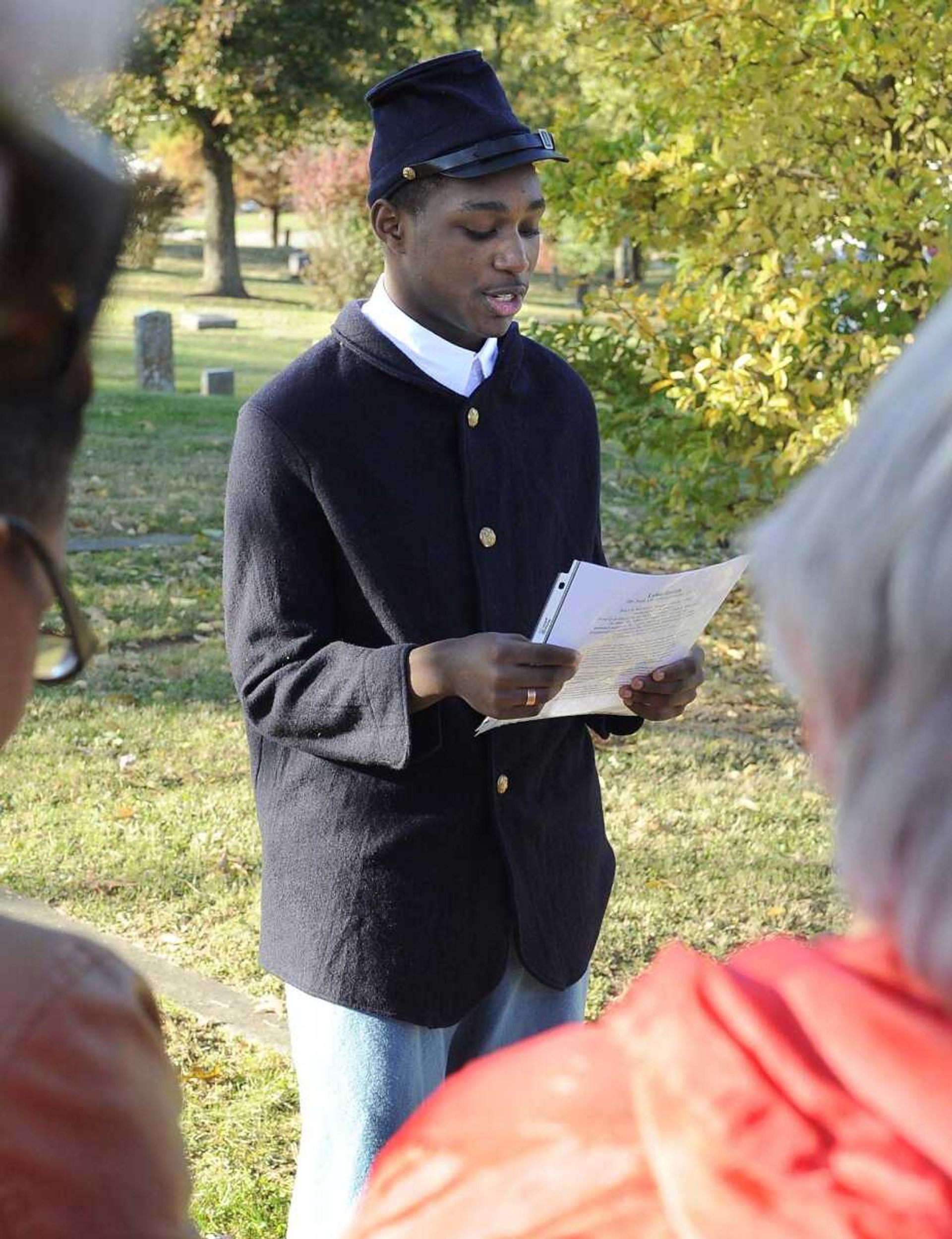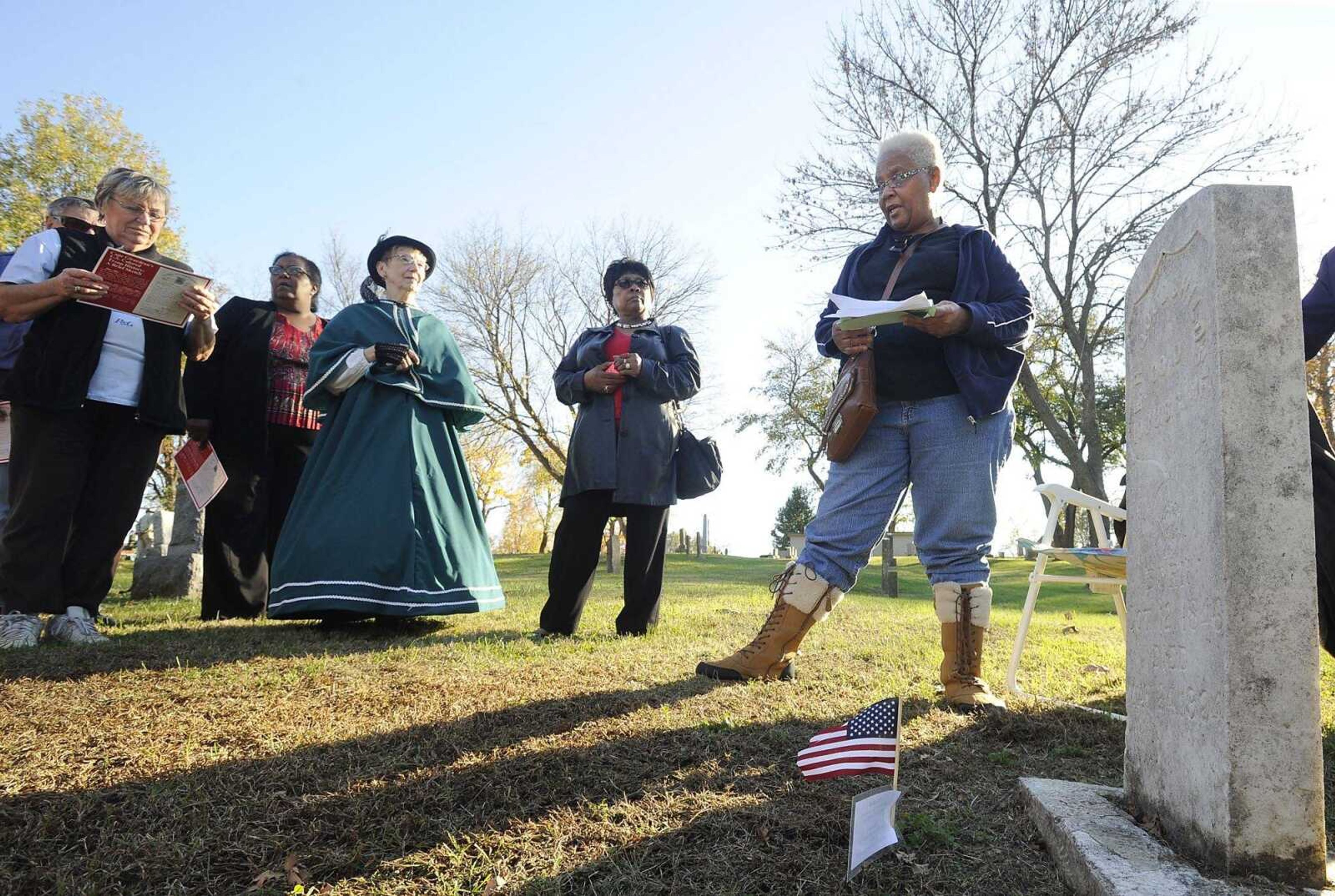Mary Lacey grew up in Cape Girardeau and remembers visiting Fairmont Cemetery as a young girl. But back then, she thought black people were buried only in the northeast portion.
"I even asked, but until today, I didn't even know there were any blacks buried in this part of the cemetery," she said, standing among the oldest of Fairmont's graves.
She and fellow resident Brenda Newbern were among the dozens who gathered at the cemetery Sunday afternoon for a Veterans Day celebration of African-American soldiers from Cape Girardeau.
The stories of 15 men were highlighted in a walking tour of the cemetery.
"It's amazing," Newbern said. "It's been 150 years, but it's never too late to say, 'Thank you.'"

Most of the gravesites were unassuming, featuring weather-worn headstones and not much else. But volunteers such as Terry Wade, in explaining their history, brought a human touch to each one.
Wade's station honored the grave of Levi Gayther, who started as a waiter for Union officers during the Civil War but became one of the first black men in Cape Girardeau to enlist in the Union Army when he gained his freedom in 1865.
Wade's presentation went further than Gayther's military record. He talked about Levi's wife, Sarah, who at one point was owned by George Bollinger at a slave. He explained Gayther's enjoyment of playing cards, despite being cross-eyed.
Wade said he's not fond of public speaking -- or history, for that matter -- but Gayther's story inspired him.
"I feel good reading this. It seems like it's stimulated me," Wade said. "It's like putting yourself into it. I love it. I wasn't really a history buff, but this might make me one."
Another presenter, Steven Lee, felt especially connected to the man he represented, Jesse Cooper.
"My great-grandfather was a slave," he told a group of attendants. "My grandfather actually knew the Coopers. They were family friends."
At 14, Jesse Cooper was sold to James Cooper and would later accompany his owner's son, James P. Cooper, when the son became a captain in the Confederate Army. Jesse became a cook for Cooper's company, survived the war and later settled in Cape Girardeau.
The event was special for Lee not only because of a familial connection but because he's a veteran himself. Lee served in the Navy from 1973 to 1976 in Vietnam.
"What happened is these guys had fought way before I did," Lee said. "But the way I see it, they don't have any family or friends to come and honor them, so it's really been an honor to be able to do this for them."
Some of the stories highlighted the chaos and dark irony of the Civil War era. Gayther served in the Union Army, and Cooper was made to be a part of the Confederate. But another soldier, John Gale, did both.
As volunteer Denise Mitchell explained, Gale's life was "filled with unbelievable tragedy."
At 6, he and his father were sold, separating them from Gale's mother and siblings. At 12, his father was sold as well, leaving him alone. He never saw any of them again.
In his early 20s, he served as a "walking boy" to the Mississippi man who bought him, providing ancillary support to the man's contingent of Confederate soldiers. Mitchell said despite his situation, he never lost hope. He even was granted a service revolver.
Midway through the war, the Confederate force he served was defeated, and Gale was offered the opportunity to join the Union Army. He gladly became a mule driver in a heavy artillery regiment, serving alongside white men.
"But the winter of 1864 was unusually cold," Mitchell said. "While he was driving the wagons, his feet froze."
It crippled his right foot. He was partially lame for the rest of his life.
Mitchell produced a copy of a sepia photograph that showed Gale, with stern, white-bearded countenance and dragging his bad foot, being helped down dusty Main Street in 1914 Cape Girardeau by Jake Rübel, a white comrade who also served in the artillery regiment.
"Later on, he did marry and have children," Mitchell said. "So there was that happiness."
Visitors marveled at the man's lifelong sacrifices. Across the cemetery, O'Ryan Gardner, dressed in a Union uniform, portrayed another man who sacrificed, Luke Smith.
"The records weren't clear, but he was born around 1846," Gardner said, "which meant he was only around 17 or 18 when he became a Union soldier."
Gardner is 16, and like Smith, is black. He skateboards, likes music and toys with aspirations of becoming a graphic designer. But if had he been born the same time as Smith, he too would have been pulled into the war or worse. He said that's why it's important to him to share Smith's story, especially near Veterans Day.
"They never got the chance to make the decisions that I get to make today," he said. "When I first heard the idea [of portraying a soldier for the event], I was nervous to represent the dead, God rest his soul. But the more I thought about it, it feels good to help them get the type of recognition that they deserve."
He said his research has contextualized the sacrifice of soldiers throughout history, but especially that of the Civil War soldiers in Fairfield Cemetery.
"Slavery tried to strip the humanness away from these people, but they never lost it," he said. "They fought and became spouses and fathers. They lived. And nobody can take that from them."
"Just to know that their graves are here is very important," Newbern said.
Her friend, Mary Lacey, agreed.
"It's good to see Cape Girardeau is finally coming of age about this history. It's really amazing to be able to hear these histories told in a positive way," Lacey said. "To know that they weren't just slaves, but they were soldiers as well."
tgraef@semissourian.com
(573) 388-3627
Connect with the Southeast Missourian Newsroom:
For corrections to this story or other insights for the editor, click here. To submit a letter to the editor, click here. To learn about the Southeast Missourian’s AI Policy, click here.







